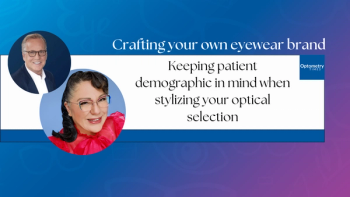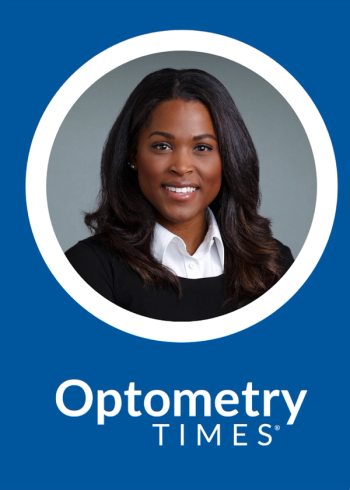
AOA 2024: Fitting multifocal contact lenses like a pro
Key steps include getting a new refraction, nailing the add power, and managing patient expectations.
Kurt Moody, OD, FAAO, Director of Professional Education for Johnson and Johnson Vision, and Shane Kannarr, OD, of Kannarr Eye Care discuss their approach to fitting soft multifocal contact lenses at the 2024 AOA meeting in Nashville, Tennesse. They emphasize the importance of accurate refraction, using a red-green balance, determining ocular dominance with the sensory method, and selecting the appropriate add based on age norms.
Video transcript
Editor's note: This transcript has been lightly edited for clarity.
Kurt Moody, OD, FAAO:
Hi, I'm Dr. Kurt Moody. I'm the Director of Professional Education for Johnson and Johnson Vision. Thrilled to be here in Nashville for the AOA.
Shane Kannarr, OD:
I'm Dr. Shane Kannarr. I practice in Pittsburg, Kansas with Kannarr Eye Care, a general optometric practice serving the needs of patients of all demographics.
Moody:
So, I'd like to tell you a little bit about what we're doing, something a little unique this year at AOA. And that's the fact that I'm going to be up on the Eye Stage. So the Eye Stage happens to be in the exhibit hall. And what I'll be talking about is educating doctors on the keys to becoming successful with fitting a soft multifocal contact lens. Now, you may say, why is that important? You know, 41% of an average optometric doctor's wearer base are presbyopes. And our data tells us that about 94% of those people hope, anticipate, and expect to still be wearing contact lenses into their 6th decade of life. Perfect business opportunity for us as an optometrist, right? We've got a big group of people; they want to stay in contacts. You know what the unfortunate truth is? One out of every 2 drop out of contacts. It's because of vision, comfort, or dryness. So how do we alleviate that? We've become really good at fitting multifocals with some really good materials. And that's really where Acuvue comes in.
So what I'll be doing on that Eye Stage is walking doctors through the keys to becoming successful at fitting these multifocals. To be honest with you, it's really easy. You do some of our key steps, do a good refraction. I love to tell doctors to do a red-green balance, determine ocular dominance with the sensory method, and finish up by really selecting the proper add. How do I select add? To be honest with you, I use age norms. If I have a patient in the 40s, I give them a low-low. If they're in the 50s, I give them a mid-mid. If they're in the 60s, I give them a mid-high with our system. And guess what? Our data tells us that 92% of the time when you do that, with our Max multifocal, you're going to get fit success on the first set of lenses [during] the first visit. So just do those steps, do what we do with so many of our patients, do a good exam, and guarantee you success.
Kannarr:
So today we're going to be speaking about fitting multifocals and how to minimize chair time. And I always like to reference minimizing patient time as well. We have to realize our patients like to be in our offices the least amount of time they can. So there's a few simple tips I think that really move multifocal fitting across the board and expediate it and provide a much higher success rate [inaudible]. First, having a great baseline refraction. I see many people who fall back on an old refraction. Make sure you get a new refraction and utilize the duochrome test, especially for those patients say 35 to 55, where there's still some accommodative system in place. By utilizing this, we prevent over-minusing, which really can be the death of our multifocal fits.
Moody:
Yes, I had just first of all talked about the fact that you want to do that good refraction, do a red-green balance. Our data tells us that when you do that red-green balance, about half of the time, you're going to find you could actually reduce the amount of minus, so you want to get that spot-on refraction. The second thing is ocular dominance. You need to do it by the sensory method, not the sighting method. Sighting and sensory match about 60-80% of the time. So that means if you're still doing sighting, you know, that old method like this, you're going to be wrong 20-40% of the time.
Kannarr:
And using a multifocal fitting we're concerned with sensory dominance. There's 2 ways to do that, depending on if you have a mechanical or an automated phoropter. If you have a mechanical phoropter, it's very simple. Display a 20/30 line, both eyes open, reassure your patient that they're not going to see as well with either of the 2 choices you're about to give them, but you want to know the best of the 2. Then simply click the red lens into the right, click it out, click the red lens into the left. Which of those 2 choices provides the patient the best vision? That allows a simple test to see where they're going to tolerate a little over plus at a distance. If it's an automated phoropter, I just have a loose trial lens. I hold a +1.50 trial lens or each lens well instead of clicking on a red lens and doing exactly what I just discussed.
Moody:
And then the final piece is really selecting the right add. Unfortunately, a lot of doctors overprescribe the add because they're selecting the add as if it was a progressive bifocal, and we're not a progressive bifocal. You use those age norms, and that's really going to drive success.
Kannarr:
The third key to multifocal success is determining functional add needs. We have a tendency to want to overplus our patients at near, and in reality, 20/20 near type is rarely used in today's world of technology. Really, 20/40 is a great baseline for us to look at. So determine functional add in a variety of ways. I use cross cylinder, binocular cross cylinder, and give them a type that's reflective of what they're actually going to see.
The fourth fitting tip is to use the fitting guide. Whatever product that you're using, make sure you follow the fitting guide. And I think in optometry, we all have this desire to cowboy it up or to maybe slightly underminus the patient, because of some things we've seen with the lens and lens design, and many of the new technologies are doing that for us. So don't go out of the box. Follow the fitting guide. I could simply show you 4 lenses and 4 fitting guides and the same patient would have 4 different prescriptions.
And then the last is to have a discussion with your patient about what their outcomes and realistic expectations are. If this patient wants to read serial numbers on a metal plate in the dark upside down, we're probably not going to get that with a multifocal lens in general. But if we have the patient wanting to be able to read their cell phone and menus and go shopping, we're going to meet that expectation. And I tell many of my multifocal wearers, you're going to be putting on reading glasses for very small or non-routine tasks. But if I free you up from glasses over 90% of the time, that's a real success. And at that point, I've under promised and over delivered.
Moody:
So I think for a doctor really be successful, it's spending a little extra time to letting them know a little bit about how this technology works. And that's the benefit of a contact lens, as we all know. You don't have to look down to be able to see. So let's say that you're underneath the kitchen cabinets, trying to do a little adjustment, maybe to some of the plumbing, you know, and we know the problem that you've got, with specs, you gotta lean your head back to see it. You don't need to do that with a contact. So I think if we spend a little extra time with the patient, letting them know the advantages of a soft multifocal over progressives—now, don't get me wrong; I think the best for our patients is both. We should have good progressives, and we should have a good set of multifocals. But I think spending that extra time and letting them know about the advantages of these lenses allows them to make a really a good a good decision on their behalf.
I think what you see with our pupil-optimized design, what we've done that's been really unique with our multifocal system is the fact that we've alleviated some of what we used to call the art of fitting, and now you've got the science of fitting. So I think that was one big thing. And the second big technology difference is what we've done here with Max. The fact that we have a blue light filter. Now, we have to understand there is no health advantage with blocking blue [light], but we've got some great data that shows that there's a vision benefit. So what we're doing is we're elevating vision with a new technology because we know these contact lenses are splitting light. So there is a little bit of a compromise. Anything that we could do to reduce that compromise is going to give us better success, and that's really where technology comes in.
Kannarr:
I think those are the key things for us to look at. So make sure that we check duochrome and don't overminus; make sure that we determined sensory, not sighting dominance; we determine a functional add; we follow the fitting guide; and last and final step, have real discussion about what patient expectations should be and reinforce those to the patients at followups.
Moody:
No, I think really, the key takeaway is be cognizant of the way you're coming up with your numbers. I mean, it's like anything else; you need solid data to get a good end result. So if you do those steps right, if you do a good refraction, if you do sensory dominance, don't over prescribe the add, success is going to come.
Newsletter
Want more insights like this? Subscribe to Optometry Times and get clinical pearls and practice tips delivered straight to your inbox.



















































.png)


